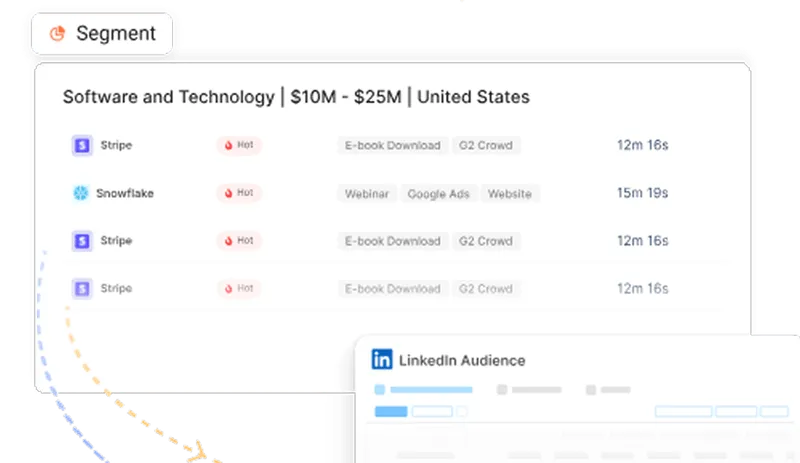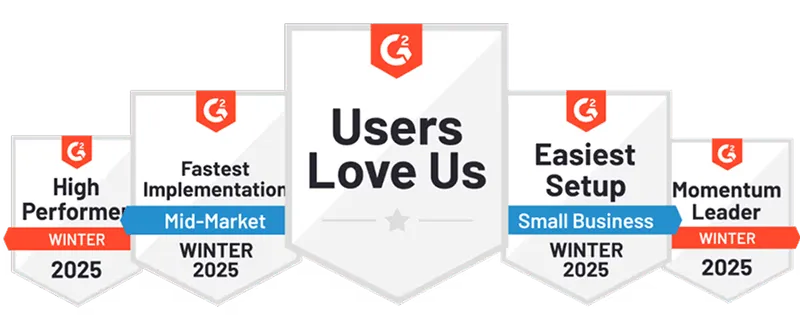Guide to Predictive Account Scoring
Learn how predictive account scoring helps B2B teams identify high-value opportunities, improve conversion rates, and align sales and marketing efforts.
Sales and marketing teams often waste time on accounts that do not convert, missing high-potential opportunities. This misalignment drains resources, frustrates teams, and slows revenue growth. In B2B, where buying decisions involve many stakeholders and long sales cycles, the stakes are even higher.
Companies generate an average of 1,877 leads per month, yet only 20% convert, leaving significant revenue untapped. The solution? Predictive account scoring. By analyzing past and current data, predictive account scoring ranks accounts based on their likelihood to convert, enabling your team to focus on those most likely to succeed.
This guide explains what predictive account scoring is, its benefits, and how to utilize it to enhance your B2B sales strategy and increase ROI.
TL;DR
- Predictive account scoring leverages historical and current data to rank B2B accounts based on their likelihood of conversion, allowing for a focused approach on top opportunities.
- Unlike traditional lead scoring, which evaluates individuals, this approach evaluates entire organizations, making it ideal for complex B2B sales.
- Building a predictive account scoring model involves defining your ideal customer profile, gathering quality data, assigning weights to key attributes, and using machine learning for continuous improvement.
- Platforms like Factors offer advanced predictive scoring features, providing valuable insights and seamless integration for B2B teams.
What is Predictive Account Scoring?
Predictive account scoring ranks business accounts based on their likelihood of becoming customers. It uses machine learning and historical data to identify patterns associated with successful conversions. Unlike traditional methods, it doesn't rely on fixed rules or manual input. It considers factors like company size, industry, website visits, and marketing responses to generate a score for each account.
Also, read Predictive Account Scoring vs. Manual Account Scoring
Sales and marketing teams use this score to focus on accounts that match the ideal customer profile and demonstrate a strong level of interest. In B2B, where many people influence decisions and sales cycles are lengthy, predictive account scoring helps target the best opportunities, boosting efficiency and the likelihood of closing significant deals.
Core Benefits of Predictive Account Scoring
Here are the core benefits of predictive account scoring:
- Improves focus on high-potential accounts: Predictive account scoring highlights companies that are most likely to convert, enabling sales and marketing teams to direct their efforts toward accounts with the highest ROI potential, rather than spreading resources thinly.
- Leverages historical data and engagement signals: By analyzing past performance data, firmographics, technographics, and behavioral signals, the model identifies patterns common among successfully closed deals, helping to surface lookalike accounts.
- Reduces time wasted on poor-fit prospects: Rather than pursuing leads that are unlikely to convert, teams can filter out low-scoring accounts early. This enables more efficient prospecting and minimizes time lost on unqualified opportunities.
- Enhances sales and marketing alignment: A shared scoring model ensures both teams are working from the same set of priorities, which improves coordination, reduces friction, and ensures a smoother handoff between marketing-qualified and sales-qualified accounts.
- Minimizes human bias and manual errors: Unlike manual scoring or gut-feel prioritization, predictive models use objective data, reducing inconsistencies and removing personal biases that often lead to inefficient targeting.
- Shortens sales cycles: When teams focus on the right accounts from the start, they’re more likely to engage decision-makers early, anticipate needs better, and move deals through the pipeline faster.
- Boosts revenue growth: By improving account targeting and conversion rates, predictive account scoring enables organizations to close more deals, reduce acquisition costs, and drive sustainable revenue growth.
For more insights on improving sales performance, check out our B2B Sales Solutions.
Key Components and Data Sources in Predictive Account Scoring
Here are the key components in predictive account scoring:
- Firmographic Data: Includes company attributes such as size, industry, location, and revenue. This helps define your ideal customer profile and segment accounts based on business relevance.
- Technographic Data: Details the technologies and tools a company uses (e.g., CRM systems, marketing automation). Knowing their tech stack can indicate budget, sophistication, and compatibility with your solution.
- Behavioral Signals: Captures engagement actions, such as website visits, content downloads, and demo requests, revealing how actively an account is interacting with your brand.
- Intent Data: Reveals the topics or solutions a company is researching online, indicating real-time buying interest and providing a competitive edge in timing your outreach.
- Internal CRM Data: Includes historical interactions, lead status, deal history, and notes from sales teams, offering valuable context and a record of the account’s past behavior.
- Third-Party Data Sources: Supplement internal data with external insights, such as company news, funding events, hiring trends, or market expansion, thereby enriching the scoring model.
- Integrated Predictive Modeling: Combines all of the above data types using AI and machine learning to assign accurate scores, prioritize accounts, and forecast conversion likelihood.
How to Build a Predictive Account Scoring Model?
Here’s an elaborated step-by-step breakdown of how to build a predictive account scoring model:
1. Define Your Ideal Customer Profile (ICP)
Start by outlining what a high-value account looks like for your business. Use firmographic and behavioral traits such as industry, company size, revenue, tech stack, and buying behavior to create a clear benchmark for target accounts.
2. Collect and Clean Relevant Data
Pull data from all available sources such as CRM, marketing automation platforms, web analytics, intent data providers, and third-party tools. Clean this data to eliminate duplicates, fill in missing fields, and standardize formats to ensure high-quality inputs for modeling.
3. Identify Key Predictive Attributes
Analyze historical data to uncover patterns in accounts that converted successfully. Common indicators include frequent website visits, specific content engagement, industry verticals, or the presence of decision-makers. Identify the attributes most closely associated with conversions.
4. Assign Weights to Attributes
Not all traits are equally influential. Assign weight or importance to each attribute based on how strongly it correlates with successful deals. This helps the model prioritize more relevant factors when calculating scores.
5. Train a Predictive Model
Use machine learning or statistical techniques (e.g., logistic regression, random forests) to train a model using your historical data. The model will learn which combinations of traits are most likely to lead to account conversions and generate predictive scores.
6. Test and Validate the Model
Validate your model by comparing its predictions to known outcomes, such as successful versus failed accounts. Evaluate metrics such as precision, recall, and AUC-ROC to assess its performance. Iterate and fine-tune based on validation results.
7. Deploy and Integrate into Workflows
Integrate the scoring model into your CRM and sales/marketing tools so teams can access scores in real time. Align processes to focus on high-scoring accounts and regularly update the model with new data to ensure its accuracy and relevance.
For more on automating these processes, check our Workflow Automations.
Best Practices to Implement Predictive Account Scoring
1. Maintain High-Quality, Up-to-Date Data
Ensure your CRM and other data sources are accurate, complete, and consistently updated. Clean data is foundational for generating reliable predictive scores.
2. Align Sales and Marketing on ICP
Collaborate across teams to define a shared Ideal Customer Profile (ICP). Agreement on what constitutes a “high-potential account” ensures unified targeting and prioritization.
3. Automate Data Collection and Scoring
Use tools that integrate seamlessly with your CRM and marketing platforms to automate the gathering, updating, and scoring of account data. This reduces manual errors and increases efficiency.
4. Regularly Evaluate Model Accuracy
Test your model by comparing predicted high-value accounts to actual outcomes. Use this performance feedback to refine your model and improve its predictive power over time.
5. Involve End-Users for Feedback
Gather insights from sales reps and marketers using the scores. Their feedback helps fine-tune the model to reflect real-world account behavior better and improve user adoption.
6. Document Scoring Logic and Processes
Clearly outline how scores are generated, what data is used, and how decisions are made. This transparency helps with onboarding, training, and internal trust in the system.
7. Revisit and Update the Model Periodically
Markets and customer behaviors evolve. Schedule regular reviews to reassess attribute weights, data sources, and scoring criteria, ensuring your model remains aligned with evolving conditions.
Common Challenges in Predictive Account Scoring and How to Overcome Them
Implementing predictive account scoring in B2B settings can be a challenging task. Some common challenges and how to overcome them are:
1. Poor Data Quality
Outdated or incomplete CRM data can compromise scoring accuracy.
Solution: Implement regular data audits and establish clear guidelines for teams to maintain and update records consistently.
2. Misalignment Between Sales and Marketing
Disagreements on what defines a high-value account can disrupt scoring consistency.
Solution: Organize joint workshops to collaboratively define and refine the Ideal Customer Profile (ICP).
3. Technical Complexity
Complex scoring models may be difficult for teams without data expertise to adopt or trust.
Solution: Choose intuitive, no-code or low-code platforms and offer training to simplify adoption.
4. Lack of Model Maintenance
Static models degrade over time if not updated with new data or market dynamics.
Solution: Schedule periodic reviews to evaluate and recalibrate scoring models for ongoing accuracy.
5. Low Team Engagement or Buy-in
If teams don’t understand or trust the model, usage drops.
Solution: Communicate the scoring methodology, involve users in the development process, and showcase early wins to boost confidence.
Metrics to Track Predictive Account Scoring Effectiveness
To measure the effectiveness of predictive account scoring, focus on clear, actionable metrics. Some of the metrics to track are:
1. Conversion Rate by Score Tier
Measure the frequency at which high-, medium-, and low-scoring accounts progress through the funnel to assess how effectively the model identifies sales-ready accounts.
2. Sales Velocity Across Tiers
Track how quickly deals close for different score groups to identify where your process is most efficient or where delays occur.
3. Revenue Attribution by Score
Determine which score segments contribute most to overall revenue to validate the scoring model’s alignment with business outcomes.
4. Sales Rep Adoption and Activity Alignment
Monitor whether reps are actively focusing on high-scoring accounts and aligning their efforts with the model’s recommendations.
5. Engagement Rates for High-Scoring Accounts
Assess whether marketing and sales outreach is resonating with top-tier accounts through email opens, meeting bookings, or demo requests.
6. Win Rate by Score Tier
Evaluate how often accounts in each score tier result in closed deals, helping further calibrate and validate the model’s accuracy.
7. Model Refresh Frequency and Accuracy Over Time
Track how often your model is updated and whether its predictive power improves with each iteration.
For more on tracking performance, check our Funnel Conversion Optimization page.
Predictive Account Scoring in the Factors Platform
The Factors platform simplifies predictive account scoring for B2B teams. It automatically collects and analyzes engagement signals like visits to pricing pages, demo video views, and email replies. Factors then assigns scores to accounts based on real behaviors. Unlike manual spreadsheets, Factors presents these signals in sortable columns, offering a clear view of account activity.
Its predictive scoring uses historical data to estimate the likelihood of actions like booking a demo or responding to outreach, eliminating guesswork. This enables marketing and sales teams to concentrate on accounts with the best conversion chances, align their strategies, and utilize resources efficiently. With seamless integration into your tech setup, Factors transforms raw data into actionable insights, helping you close more deals and grow revenue effectively.
Wrapping Up
Predictive account scoring revolutionizes how B2B companies identify and focus on valuable opportunities. By leveraging historical data and behavior signals, companies can target accounts more likely to convert, accelerating sales and increasing revenue. Unlike traditional lead scoring, this method evaluates the entire account's engagement, making it ideal for complex B2B sales with multiple decision-makers.
When executed well, with clean data, the right tools, and team cooperation, predictive account scoring provides valuable insights that align marketing and sales efforts, enhance targeting, and drive business growth. Platforms like Factors demonstrate that predictive account scoring is now essential for competitive B2B teams. Adopting this method enables your organization to make more informed decisions, refine its outreach, and close more deals with less effort.
See how Factors can 2x your ROI
Boost your LinkedIn ROI in no time using data-driven insights


See Factors in action.
Schedule a personalized demo or sign up to get started for free
LinkedIn Marketing Partner
GDPR & SOC2 Type II
.svg)










